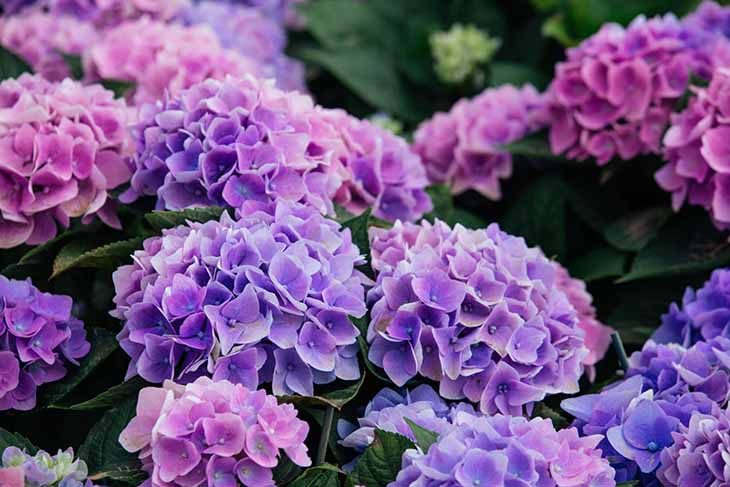The hydrangea is an absolutely beautiful flower. It is even one of the most popular ornamental plants for gardens or balconies. White at the base, depending on the pH of the soil, hydrangeas evolve and metamorphose, revealing a range of shimmering colors, oscillating between pink, red, blue, purple and green. The color of the flowers of this shrub depends on the acidity of the soil in which you planted it. Thus, the hydrangea flowers are completely transformed, as if by magic! With their variety of shapes and diversity of shades, no wonder they are often nicknamed “magic flowers”.
Native to Asia and North America, this resistant plant is very appreciated for its chameleon-like appearance. Its elegant flowers decorate the garden, but they can also be grown in pots. As a bonus, hydrangeas are easy to care for and bloom abundantly. As long as you water it frequently!
Want to enjoy its decorative flowers, perfect for beautifying your interior? All you need to do is follow these few tips to take good care of your hydrangeas and enhance your garden.
What are the secrets to a healthy and colorful hydrangea? We tell you everything.
The Water

Hydrangeas need a lot of water, so water them very often in summer and make sure the soil is always moist, especially if they are in a pot. In winter, on the other hand, they should only be watered from time to time, when the soil begins to dry out.
Once they have flowered, they no longer need too much water, but it is still important to water them at least once a day.
Warning: this plant is very sensitive to variations in the pH of the soil in which it immerses its roots. It is therefore preferable to use rainwater or water at room temperature, but never too cold.
Temperature and Light
Contrary to what you might think, hydrangeas don’t like direct light. Better to place them in a bright place in your garden or balcony, but not in direct exposure to the sun.
The ideal temperature for hydrangeas is 18°C. Avoid too high a temperature, too much light and too much heat. This can trigger stem loss.
In winter, hydrangeas tolerate cold temperatures quite well. If you prefer, you can place the plant indoors, keeping it near the window but away from heat sources like radiators or heaters.
When is it best to prune hydrangeas?

If your hydrangeas are still young, there is no point in pruning them. Generally, you should prune them every year starting at age three. The best time is early fall, but it depends on the variety.
To prune them properly, use sterilized shears to remove unproductive branches and old branches, which are often dry and weak. Leave at least two buds on each branch.
Dry branches over 5 years old must be removed at the base in order to ventilate the plant and avoid the appearance of fungus, mold or pest infestation.
Floor
As said, the color of the flowers depends on the pH of the soil. If the acidity of the soil changes, the color of your flowers may change as well, which is why this plant was once considered magical.
Choose well-drained soil rich in peat for your hydrangeas. If your soil is acidic, your flower will be blue. If you have limestone soil, the flowers will alternate between pink and red.
Want to play a coloring game? Here are some tips for changing the color of your hydrangeas:
If you want your flowers to turn blue, enrich your soil with alumina sulfate: simply dissolve 200 g of the product in a good quantity of watering water and to distribute around the root. Consider doing it in early spring!
Another tip: if the flowers are pink and you would like to see them turned blue, you can make the soil more acidic by fertilizing it with coffee grounds.
To have red hydrangeas, you must act on the pH of the soil by adding ash or lime. Mix a little wood ash (cold of course!) with a large quantity of water and spread the solution at the base of the plant. Water a little and you will soon see the flowers turn red!
Fertilization
You should fertilize your hydrangeas very frequently, especially during the period immediately before flowering.
Ideally, you should fertilize once a week with a potassium-rich compound that can be diluted directly in the water you water your plant with.
The Pot

Would you like to grow your hydrangeas in pots? Be aware that this shrub grows abundantly and that its roots take up a lot of space. Therefore choose pots with a diameter of at least 40 cm if the hydrangea is small. If, on the other hand, the hydrangea is of medium size, opt for larger pots with a diameter of at least 60 cm.
Diseases and Parasites
Hydrangeas, like many other plants, can unfortunately be attacked by pests or diseases.
If the plant looks distorted and the flowers are abnormal, it may be mycoplasma. In this case, the only remedy is to completely remove the affected parts.
Aphids or mites, which commonly attack the plant, can be more easily eliminated with a natural remedy based on Marseille soap and water, to be sprayed directly on the affected parts. Marseille soap will act as a perfect insecticide which will keep all aphids away!
Mold is also very common and can be combated with a mixture of two tablespoons of baking soda and a quart of water applied directly to the plant. This white powder, renowned for its cleaning properties, is also known for its anti-mold and deodorizing properties.
Finally, your plant may be attacked by mealybug, which can be eliminated using many natural remedies. One of the most effective remains Marseille soap.



